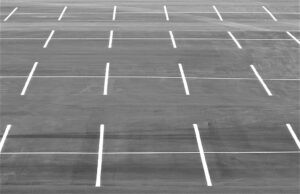- 0 Like
- 0 Comments
- By john arnold
- Asphalt Know How, Asphalt Patching, Asphalt Paving, Commercial Paving, Crack Sealing
The design of a parking lot can make a big difference with its efficiency. Here are some ways to improve upon faulty designs.
Lot Measurements
Knowing your exact parking lot measurements is very important. You may wish to start with a satellite image from Google Maps then draw in each boundary line. Some property legal descriptions include dimensions. Surveys will also typically include all of these measurements. Alternatively, take a measuring tape with you to site to precisely measure the available space. Keep in mind that a lot may have required setbacks from the property line. Further, there may be limits for the locations and widths of the entry and exit laneways for ingress and egress to the parking area.
Minimum Requirements
Individual parking stalls should be a minimum of nine feet by nineteen feet (9′ x 19′). However, special sections with slightly smaller stalls may be designated for compact cars to better utilize the area. Two-way traffic lanes have a minimum width of twenty-four feet (24′) and perimeter circulation road lanes should be thirty feet (30′). When the parking lot access opening is limited to less than thirty feet (30′) in width a separate entrance and exit should be used. The minimum entrance radius is six feet six inches (66‘- 6″}. However, eleven feet six inches (11″- 6″) is recommended. The figure below provides a guide for determining the required layout and dimensions of parking lots for both single and overlapping units.
Entry/Exit Spacing
Proper, safe spacing of entrances and exits from nearby intersections is critical in preventing back-ups of traffic attempting to enter a parking lot, which in turn can cause clogged-up intersections, rear-end accidents, and unsafe turning maneuvers. Those safe distances vary based on the traffic volumes of the driveway and adjacent streets. Other factors influencing driveway spacing include the land use the parking lot is serving and whether right-turn lanes are necessary at the driveways. Depending on all those factors, driveways are spaced 300 to 600 feet away from intersections. In the case of establishing especially large parking lots, it may be necessary to add turning lanes or even entire through lanes on adjacent streets, and possibly even signalization of parking lot entrances or intersections near them.
The industrial and commercial asphalt world is always changing. Please like this article, share this article, or visit us at https://arnoldasphalt.com.

